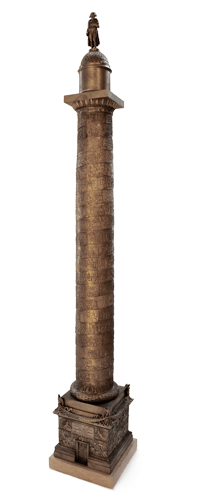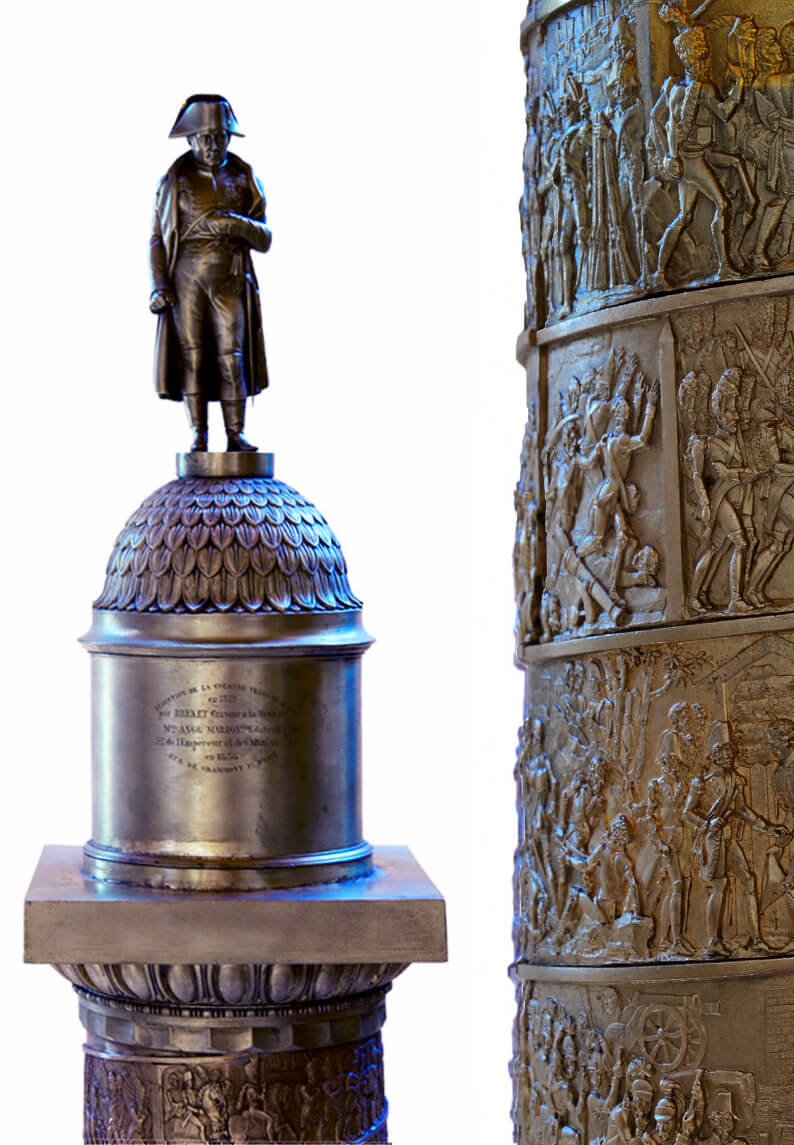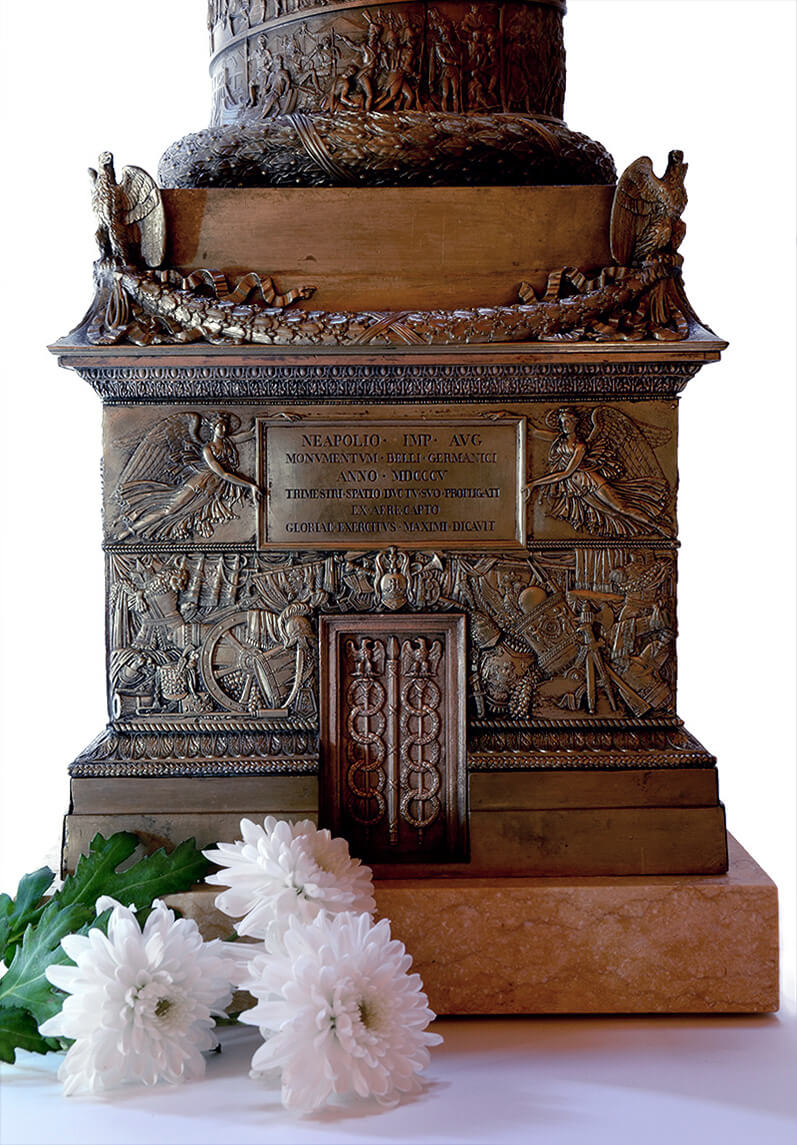
Vendome Column_, Paris
Bronze and Limestone
72″ h., 1856
Nicholas-Guy Antoine Brenet
The history of European souvenir architectural models reaches back to the later 18th century; and a century further than this when we include the olivewood, ebony, and ivory model of Jerusalem’s Church of the Holy Sepulchre, fashioned there by Franciscan friars, as mementos for the well-heeled tourist.
Across this 350 year span, we know of the production of no souvenir model more impressive than this imposingly tall, elaborately-detailed, mid-19th century, bronze replica of Paris’ Colonne Vendome.
There are one-of-a-kind miniatures even more lavishly turned out. Luigi Valadier’s late 18th century rendition of Trajan’s Column in Rome – exquisitely finished in rare marbles, semi-precious stones, and gilded bronze – is an example, and there are others. None of these unique objects, though, are souvenirs in any familiar sense – produced in multiples and made for sale, rather than on commission, available to travelers and others with sufficient interest and means.
What makes this model of the Colonne Vendome so great? There is, before anything else, its sheer forward physicality. When it comes to souvenir architectural models, the usual thing are miniatures which are miniature, several inches, maybe a foot tall, usually resting comfortably in the palms of our hands. This Colonne, on the other hand, is taller than we are, rising just above six feet, robustly proportioned, and, as the French would say, formidable.
This robustness extends to the model’s details, which are not only exactingly, faithfully rendered, but vigorously wrought. The figures at the model Column’s spiraling decoration, for example, are as fully-dimensional, as those on the Colonne in Place Vendome. This extraordinary level of care and fidelity occurs throughout the model, from its base to the surmounting figure of Napoleon, rendered in 1833 by Charles Emile Seurre, as Le Petit Corporal.
There are other large, 19th century bronze models of the Colonne Vendome (though none so grand as this one). Much of the differences between these models are matters of care and technique. For example, with other miniatures, the monument’s shafts were cast in a single thin sheet of bronze, in a mold shoes figures are more gestural than three-dimensional. With this model, in stark contrast, the spiraling shaft was cast in over 100 separate sections, each numbered, and separately fixed to a turned French oak core. This reproduces not only the monument, but the way the monument itself was constructed, with the spiral cast in dozens of segments, all fitted together, and attached to a stone core. We know of no other model whose method of assembling reproduces that of the monument it replicates!
From the outset the model proved something of a sensation. The 1834 Recueil Industriel Manufacture, et Commercial enthused: “C’est un veritable tour de force que la Colonne Vendome reduit a vingt, quadriemme par M. Brenet rien n’egale la precision et le find de ce travail” (“It is a true tour de force, this reduction of the Vendome Column at 1:24 is without equal in its precision and finish”).
The first example was purchased in 1834 for 6,000 French francs, by King Louis Philippe, who placed it in his chateau in the Tuileries. Another of these models was exhibited at that year’s Paris salon. Another example is in the collection of le Musee National de L’Armee; while a pair of smaller versions, at 1:40, are with Fondation Dosne -Thiers. We know of only a very few others.
What led to these remarkable models? Almost of course, their history is bound up with that of their maker – Nicholas-Guy Antoine Brenet, an artisan whose main occupation was making commemorative models. Nowadays, it may be thought insulting, demeaning to describe someone as obsessive or compulsive, as though these traits characterize pathology. (Collectors understand the error here.) So instead, let’s say Monsieur Brenet was conscientious, devoted.
There are somewhat varying accounts of Brenet and his remarkable model, so we’ll stick to the high points. It seems the idea for this miniature came to Brenet (1773 – 1846) shortly after the Colonne was completed in 1810. Following this, though, was a nearly two decade dormancy, broken, in the first part of 1828, by his beginning work on a wax model of the monument, at a scale of 1:24. After four years of work, he was sufficiently emboldened to approach the French state currency office, who he hoped, not unreasonably, might sponsor the model’s production (By this time, Brenet was a well known maker of commemorative medallions; and acquainted with prominent bronze artists working in their office (including Bayre, Dominique Ingres, and Marie Gatteaux).
In February, 1832, Monsieur Brenet called, unannounced, at Paris’ Hotel des Monnnaies de France, where his request for a meeting with Jean Baptiste de Sussy, the agency’s Director, was declined. Three days later, Brenet was back, Sussy relented, was impressed, and the game was on. By June, 1832, the currency office had decided to sponsor the project – though were anxious to include the model in the proposed Musee de le Monnaie – and were without money for the undertaking (an odd turn for the state agency in charge of money). They proposed to Brenet that he accept, instead of Francs, ten kilograms of platinum, which they had in storage and for which they had no place. Brenet accepted.
Since the first part of 1828, Brenet had collaborated with a young ciseleur, or carver – Dominique Eugene Clauteaux (1803 – 1825) – in sculpting the model’s various parts. His wax replica lead to the casting of dozens of elements made with lost wax process – in which was “positives” are re-made in bronze. The artisanship of the wax replicas is largely un-recorded but is said to have involved animal skin and bones. Chauteaux perished, from complications following the removal of his tonsils, on April 22, 1835, just a year after Brenet’s and his acclaimed work first saw production.
Brenet revealed his political savviness in ways other than obtaining state sponsorship for the project. By the early 1830’s, the statue of Napoleon atop the Colonne, by Antoine-Denis Chaudet (1763-1810) showing him dressed like a Roman emperor, had fallen from favor; a decline leading to the replacement, on July 20, 1833, very near the time the Colonne model was first cast, by a new Napoleon in modern military garb, by Charles-Emile Seurre (1798-1858). Brenet, cannily, ready for any change in the political winds, made both Napoleons!
While royalty and government agencies purchased the first of Brenet’s formidable models, very well-heeled private citizens soon found them available in the tony Showrooms of Pierre Victor Ledure, in rue Vivienne.
Brenet died in 1846. Before then, seeing to the future of his not-so-petite Vendome, he reached agreement with Michel-Ange Marion, a dealer in military badges, flags, and embroidery, in rue de Grammont, for the production of future editions of the Colonne model.
We’ve located fewer than five of these later editions, including ours. Engraved into the drum surmounting the offered model is “Reduction de la Colonne Vendome au 24me, en 1812, par Brenet, Graveur a la Monnaie, Mel Ange Marion, Edition, 2 de l’Emperor et des Ministres, en 1856, Rue de Grammont 13 Paris”. The Marion shop, founded in 1803, remains in business today.
The phenomenon of Brenet’s models enjoys a rich history, one complemented by the colorful story of the miniature Colonne Vendome offered here. By the middle part of the 20th century, our little Column found an important part of the décor of the famous library at Chateau de Groussay in northern France. The Chateau, built in 1815 by the Duchess de Charost, had been purchased in 1939, by the aesthete Carlos de Beistegui, described as an “eccentric multi-millionaire art collector and interior decorator and one of the most flamboyant characters of mid-20th century European life”. Famed interior designer Mark Hampton once called Groussay “the most beautiful house in the world”.
The library there, in which our column formed a focal point, was the chateau’s highlight, sufficiently transporting that it inspired Cecil Beaton’s design vision for Henry Higgins’ library in My Fair Lady. The cover of the January, 1981 Architectural Digest pictures the library, our Colonne front, and just off center.
Beistegui had died in 1970, and the Chateau had passed first to his brother, then nephew, neither of whom cared to devote their lives to keeping up the place. In 1999, Sotheby’s conducted a three day sale of the Chateau’s contents, which The New York Times described as a “major event in the history and sociology of the decorative arts”. Our column sold, for three times its estimate, to a well-known Parisian antiques dealer.
For a wonderful, and wonderfully funny, description of Groussay and Beistegui, see Dominick Dunne’s “All That Glittered” in the august, 1998, Vanity Fair. http://www.vanityfair.com/magazine/archive/1998/08/dunne199808






